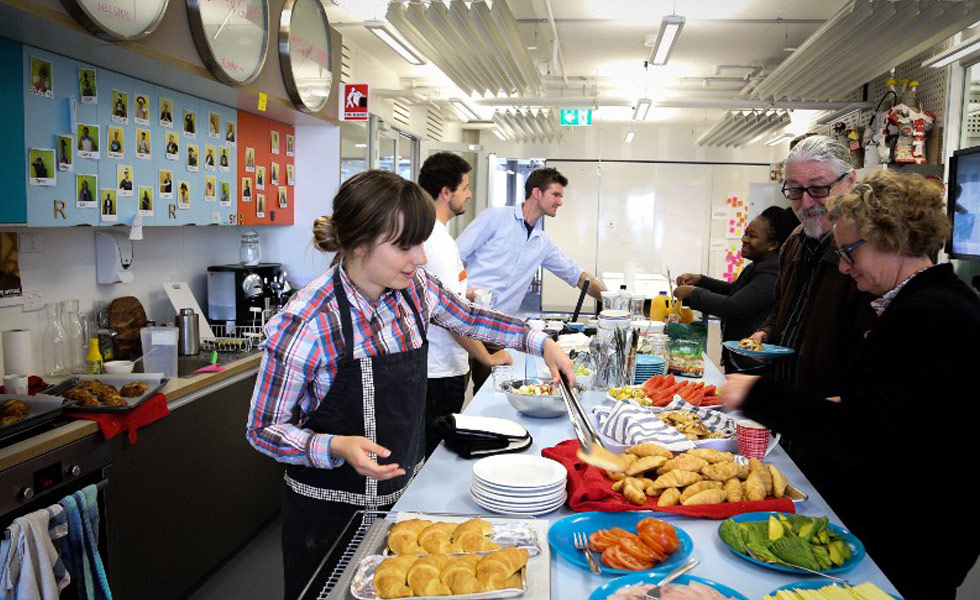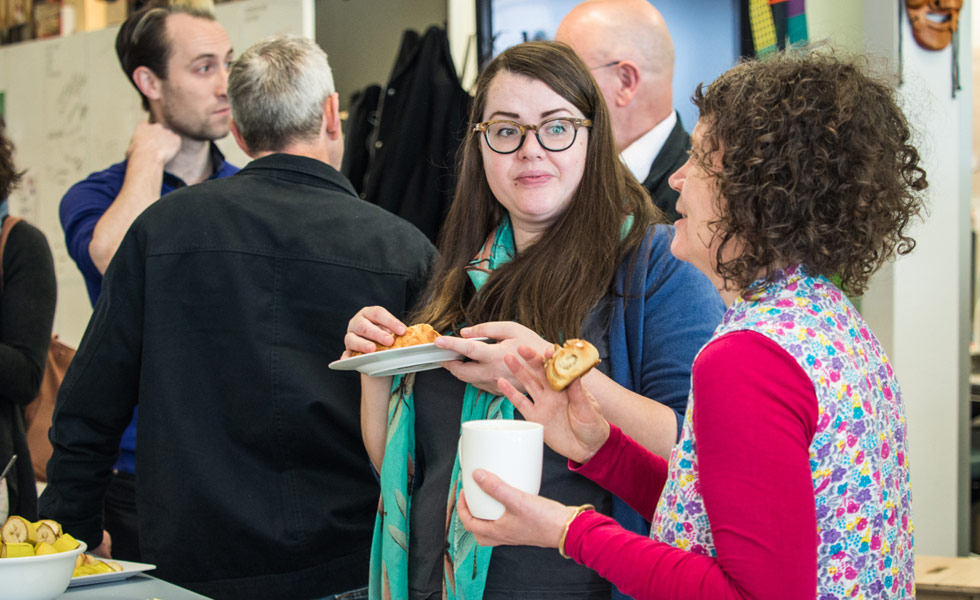Culture
Ingredients for Innovation — How the kitchen flavours SDF culture and learning

Krista Raftopoulos, a student of Professional Writing at Swinburne
15 September 2016
The kitchen is the heart of Design Factory Melbourne (DFM). It provides a different approach to learning and epitomises how DFM differs from other learning environments.
Everyone is Welcome
For a start, the kitchen is an informal space. Anyone can go there and grab a coffee or make something to eat. It’s a gathering point as well. It emphasises socialisation. It helps to build relationships and to break down barriers.

Early birds have arrived to DFM monthly breakfast.
A Level Playing Field
According to Dr Alison de Kruiff, DFM lecturer, the café culture that emerged from the 1920’s European intellectuals sparked the concept of the DFM kitchen. A moment of relaxation gets your mind away from what you’re working on.
The kitchen encourages people into one space and invites them to interact. ‘In a kitchen, no one is scared of being wrong’, Alison says.
To prepare for internationally synchronised lift-off the students have been undertaking short intense internal innovation challenges including the Paper Robot Challenge and the Flow Induced Vibration Challenge, developing their interdisciplinary collaboration and user centred design skills.
“If you’re sitting and having a chat with someone over a coffee, you’re not in a classroom and ready to be examined on your knowledge. It’s just about having a chat. It removes a lot of the pressure so people can be creative and have fun. Our innovation process is about having fun at the same time, because that’s when people are at their most creative.”
Familiar Tools, Sophisticated Learning
Kitchen-based activities are an important part of SDF methods and practices of teaching and learning. Complex concepts can be unpacked in comfortable and fun ways. For example, the kitchen is used to explore the concept of ‘innovation’- a word that means many things to many people. For teams to be effective, it’s important they develop a shared understanding of what they mean by ‘innovation’.
In the DFM kitchen, students were tasked with the challenge of creating a dessert called Innovation. Through the process of selecting ingredients, crafting their masterpieces and then ‘pitching’ them to their peers, they took important steps to building shared understanding around ‘innovation’. And they got to share the tasty results.

A dessert called ‘Innovation’!
Start with Breakfast
The DFM has a flat hierarchy environment. The kitchen reduces the disciplinary, cultural and professional barriers, as eating is a universal need. The kitchen invites collaboration and brings people together. It works on the basis that every person you meet knows something you don’t, and this encourages innovation which is at the heart of DFM.
Part of the role of the breakfasts is to facilitate the serendipitous moments. Serendipitous moments are common in the kitchen. People chat about their different projects and someone suddenly makes a comment or suggestion that changes another person’s approach to what they’re working on. According to Dr Alison de Kruiff, it’s the small ideas that can lead to amazing breakthroughs where people collaborate, and that’s the role of the kitchen.
This story was written as part of a collaboration between Design Factory Melbourne and Swinburne PAVE. The collaboration enables Diploma of Professional Writing and Editing students to work on real-life journalism projects as part of their studies. This article is part of a series of case studies and stories around DFM published in 2016.



